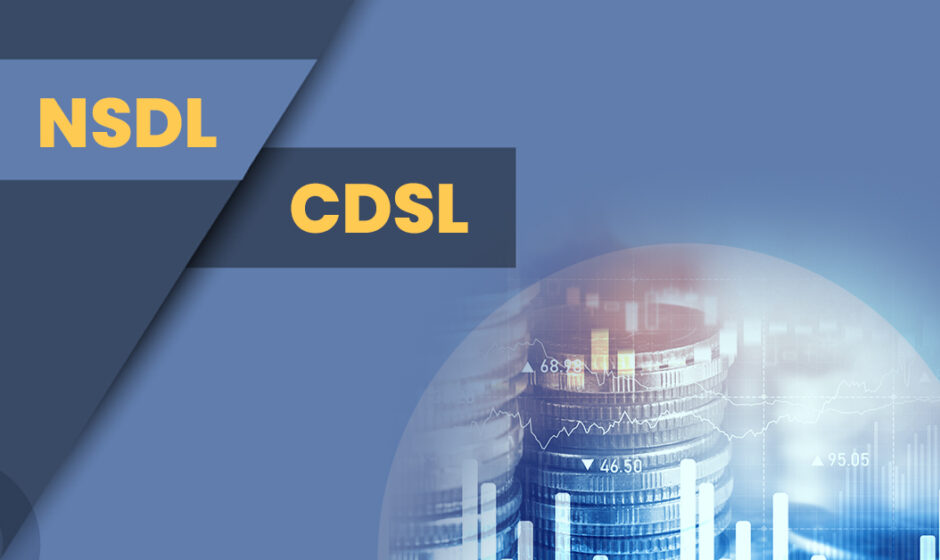National Securities Depository Limited (NSDL) and Central Depositories Services India Limited (CDSL) are government registered depositories in India. NSDL and CDSL are similar to banks for securities (shares, debentures, bonds etc.) instead of cash.
When we buy or sell a security, they are credited or debited to our demat account just like cash in our bank account. As an investor, we utilize their services through a depository participant (DP). Broker or custodian act as a depository participant.
A demat account allows you to trade, monitor your portfolio, and access your investments anytime you choose, without worrying about lost or damaged certificates. Both nsdl demat account and CDSL provide dependable services, and the decision between the two is frequently based on your own tastes and demands.
key Benefits of Holding a Demat Account with NSDL or CDSL:
- Investment Safety: Your bonds, shares, and other securities are safely stored digitally, removing the possibility of physical certificates being lost, stolen, or damaged.
- Convenient Trading: Compared to the previous paper-based method, transactions are quicker and more effective when you may purchase or sell shares quickly.
- Easy Monitoring: You can watch your portfolio, keep tabs on your investments, and check your holdings at any time with online access.
- Paperless Management: Since everything is electronic, there is no need to handle or store physical documents, which saves time and effort.
- Access to Statements and Alerts: To keep you informed and organised, you receive account statements and transaction alerts on a regular basis.
- Seamless Transfers: When necessary, you can effortlessly move your assets between brokers or depositories, giving you more flexibility and control over how you manage your portfolio.
Comparison: NSDL & CDSL
| Feature | NSDL | CDSL |
| Founded in | 1996 | 1999 |
| Market | Primary functioning with NSE | Primary functioning with BSE |
| Market Share | Higher market share compared to CDSL | Lower market share compared to NSDL |
| Promoters | IDBI bank, UTI and NSE | BSE |
| Listing Status | Unlisted | Listed |
Which Depository to Be Selected Over the Other?
Both CDSL and NSDL are highly trusted and reputable choices, so your decision can ultimately come down to what feels like the right fit for your needs.
The cdsl demat account is known for being more straightforward and user-friendly, which is great for individual investors looking for a simple experience.
On the other hand, NSDL, with its long history and tech-focused approach, appeals to investors who value a more advanced infrastructure, particularly businesses and institutions.
When picking between the two, consider what is most important to you: CDSL’s ease of use and accessibility against NSDL’s technological expertise and stability. It’s worth pausing to analyse the advantages of each.
If you’re unsure, a simple conversation with your broker or financial advisor will help you choose which option best corresponds with your goals. After all, both are solid options with dependable services, so the key is to select one that makes you feel at ease and supported.
How to Transfer Securities Between NSDL and CDSL?
To transfer securities between CDSL and NSDL use an inter-depository transfer form. This process allows you to move your holdings from one depository to the other smoothly. You’ll need to fill out the form with details like the ISIN of the securities, your DP ID, and the target depository’s information. Once submitted to your depository participant (DP), they’ll handle the transfer for you.
Conclusion
Both NSDL and CDSL offer reliable, secure, and efficient services for managing your investments through a demat account. The choice between the two largely depends on your personal preferences, such as ease of use or the need for advanced technology.
Frequently Asked Questions
1. What are CDSL and NSDL?
CDSL (Central Depository Services Limited) and NSDL (National Securities Depository Limited) are two depositories in India that facilitate the holding and transfer of securities in electronic form. Both provide services to depository participants (DPs) like banks and brokers, who, in turn, offer demat account services to investors.
2. What is the Primary Difference Between CDSL and NSDL?
The key difference lies in their association and user base. CDSL caters primarily to the Bombay Stock Exchange (BSE), while NSDL is linked mainly with the National Stock Exchange (NSE). However, both can facilitate transactions on either exchange.
3. Are the Account-Opening Processes Different for CDSL and NSDL?
No, the process of opening a demat account is similar, regardless of whether the DP is associated with CDSL or NSDL. You will need to submit KYC documents, complete a form, and follow your DP’s verification process.
4. Do CDSL and NSDL offer Different Services?
Both provide similar core services such as the dematerialization of shares, settlement of trades, and holding securities. However, the interface, additional services, and technology depend on the DP you choose.
5. Which Depository is More Secure, CDSL or NSDL?
Both CDSL and NSDL adhere to strict regulations set by SEBI (Securities and Exchange Board of India) and are equally secure. The safety of your demat account depends more on your DP’s adherence to security practices.



